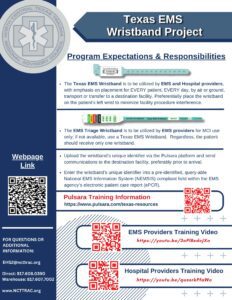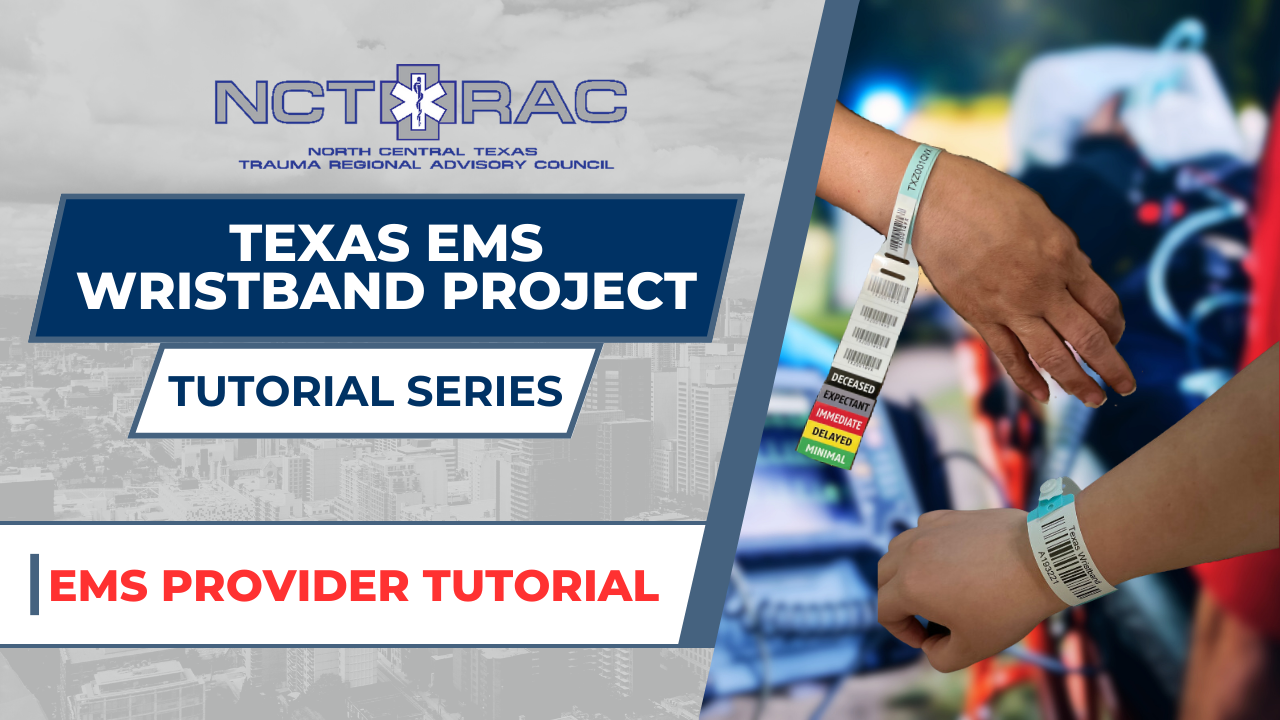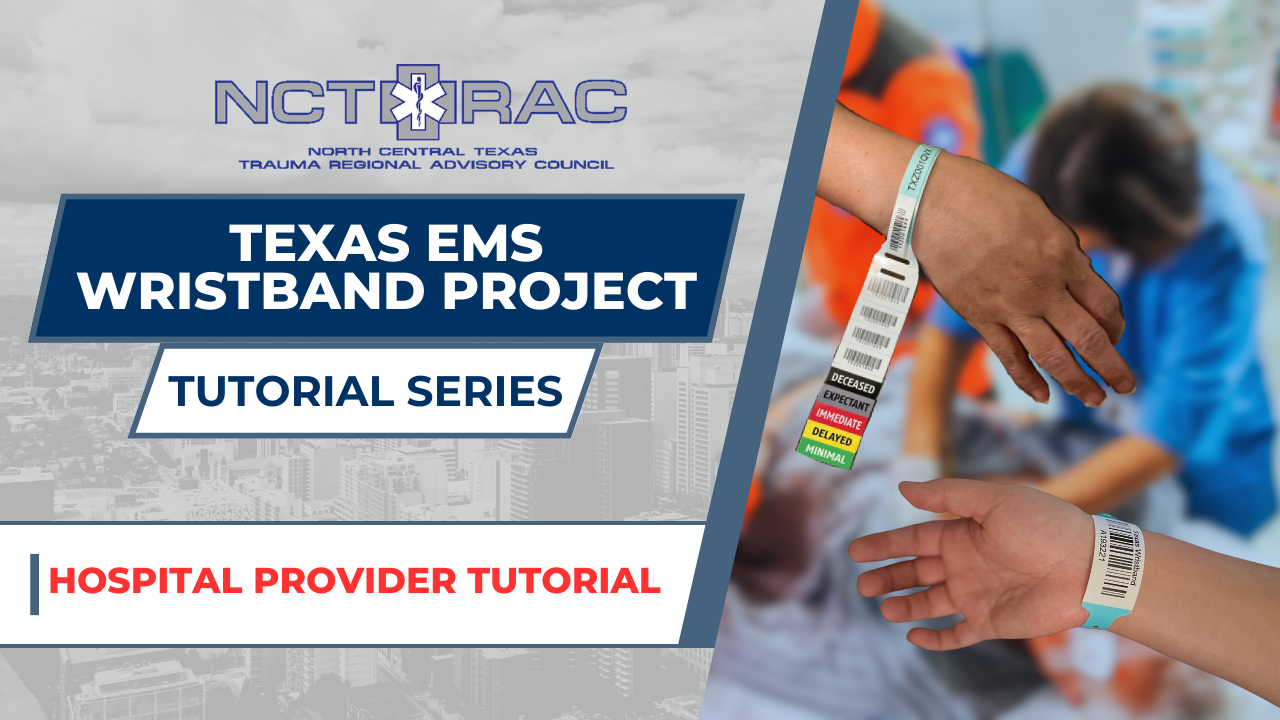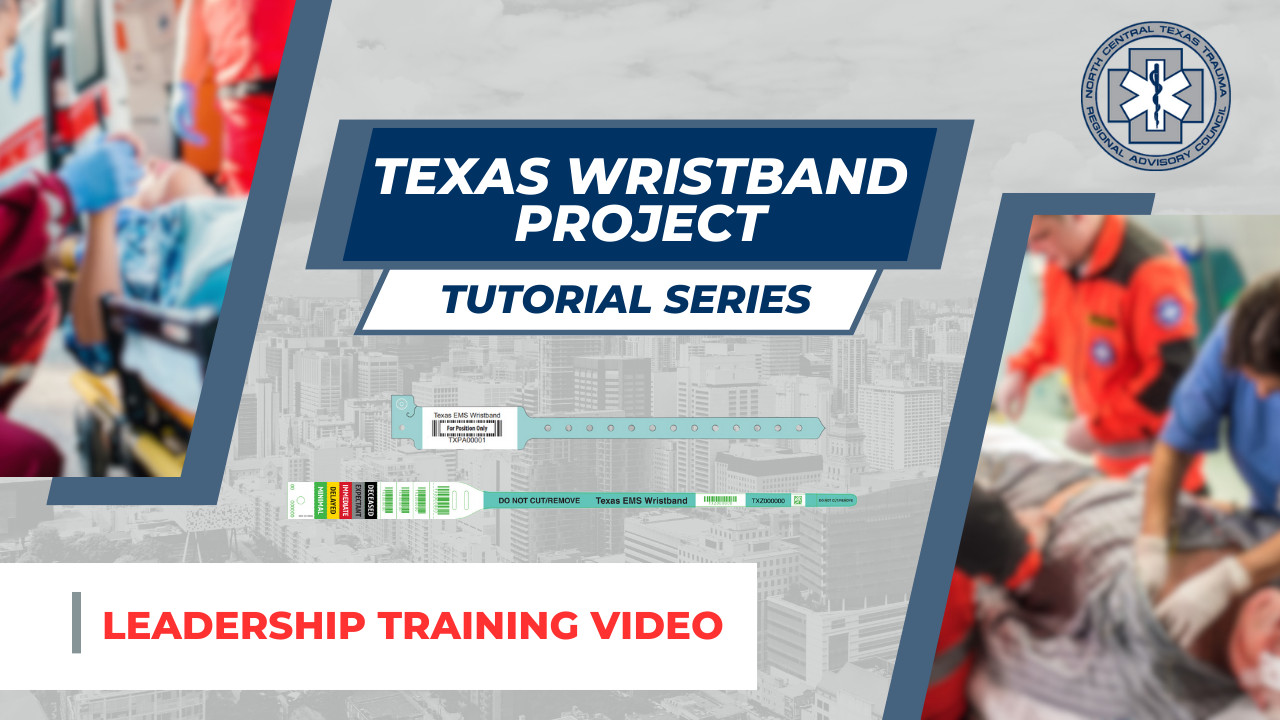TEXAS EMS WRISTBAND PROJECT
TEXAS EMS WRISTBAND PROJECT

Introduction
NCTTRAC is providing Texas EMS Wristbands and EMS Triage Wristbands to EMS, FRO, and Hospital organizations within Trauma Service Area – E to address two long-standing state-wide challenges:
- To link pre-hospital and hospital records across disparate electronic medical record systems and throughout the continuum of care
- To track patients during mass casualty incidents (MCI), evacuations, and disasters
Texas EMS Wristbands and EMS Triage Wristbands are FREE on a FIRST COME, FIRST SERVED BASIS while supplies and funds remain available. Wristbands will be appropriately distributed to DSHS-licensed EMS agencies, First Responder Organizations and hospitals to facilitate EMS transports, inter-facility transfers, and/or other NCTTRAC approved situations or events in which wristbands may be needed or required.
Both wristbands are available through NCTTRAC. While either wristband may be used interchangeably, each wristband was designed for specific use based on cost-effectiveness and functionality. Please review the specific structure and appointed organization type below:

Texas EMS Wristband: For everyday use by EMS & Hospitals only.
———————————————————————————————————————————————————————————————–

EMS Triage Wristband: For use by EMS & FRO’s only during mass casualty incidents (MCI).
EMS Program Overview
NCTTRAC recommends and encourages ALL organizations follow the program expectations and responsibilities outlined herein:
EMS Qualifications
- May request the Texas EMS Wristbands and the EMS Triage Wristbands.
- Be a DSHS Licensed Organization within Trauma Service Area-E
- Must have an active Pulsara User Account(s) for the agency
- Must have at least one (1) of the following three (3) memberships:
- NCTTRAC Membership in Good Standing*
- EMTF MOA
- HPP LOA
- Attest to viewing the Texas EMS Wristband Project: Leadership Training Video
- Willing to sign or have on file a NCTTRAC Asset Transfer Agreement
*RAC Membership in Good Standing includes:
- Completed Membership Application
- Membership Dues Paid
- Membership Approved by NCTTRAC Board
- Met Active Participation Requirements:
- Attended 6 NCTTRAC-sponsored meetings in 3 out of 4 quarters within RAC fiscal year (Sept. 1 – Aug.31)
- Data Submission per the Committee SOP
Distribution is not available to those without an EMTF MOA, HPP LOA, or NCTTRAC Membership. Please contact NCTTRAC for any questions at NCTTRAC_EHS@ncttrac.org.
Program Performance Expectations

Texas EMS Wristbands – For Daily Use
- Place a Texas EMS Wristband on EVERY patient, EVERY day, by air or ground, transport or transfer to a destination facility. Preferentially place the wristband on the patient’s left wrist to minimize facility procedure interference.
- Upload the wristband’s unique identifier via the Pulsara platform and send communications to the destination facility, preferably prior to arrival.
- Enter the wristband’s unique identifier into a pre-identified, query-able National EMS Information System (NEMSIS) compliant field within the EMS agency’s electronic patient care report (ePCR).

EMS Triage Wristbands – For MCI events only
- Use the EMS Triage Wristband for MCIs only, if not available, use a Texas EMS Wristband. Regardless, the patient should receive only one wristband.
- Upload the wristband’s unique identifier via the Pulsara platform and send communications to the destination facility, preferably prior to arrival.
- Enter the wristband’s unique identifier into a pre-identified, query-able National EMS Information System (NEMSIS) compliant field within the EMS agency’s electronic patient care report (ePCR).
Pulsara Requirement
At the minimum, EMS, FROs, and Hospitals MUST be enrolled in Pulsara, have active Pulsara user accounts, and be willing to utilize Pulsara in MCI events in order to receive Texas EMS Wristbands and/or EMS Triage Wristbands through NCTTRAC. Please note, Distribution is not available to those without active Pulsara accounts. For information or help with enrolling in Pulsara; utilize the buttons on the right-hand side of the webpage for each organization type.
FRO Program Overview
NCTTRAC recommends and encourages ALL organizations to follow the program expectations and responsibilities outlined herein:
FRO Qualifications
- May only request the EMS Triage Wristband
- Be a DSHS Licensed Organization within Trauma Service Area-E
- Must have an active Pulsara User Account(s) for the agency
- Must have at least one (1) of the following three (3) memberships:
- NCTTRAC Membership
- EMTF MOA
- HPP LOA
- Attest to viewing the Texas EMS Wristband Project: Leadership Training Video
- Willing to sign or have on file a NCTTRAC Asset Transfer Agreement
Distribution is not available to those without an EMTF MOA, HPP LOA, or NCTTRAC Membership. Please contact NCTTRAC for any questions at NCTTRAC_EHS@ncttrac.org.
Program Performance Expectations

EMS Triage Wristbands – For MCI Events Only
- FROs will only be receiving the EMS Triage Wristband for MCI use only. As a reminder, patients should only receive ONE wristband.
- Upload the wristband’s unique identifier via the Pulsara platform and send communications to the destination facility, preferably prior to arrival.
Pulsara Requirement
At the minimum, EMS, FROs, and Hospitals MUST be enrolled in Pulsara, have active Pulsara user accounts, and be willing to utilize Pulsara in MCI events in order to receive Texas EMS Wristbands and/or EMS Triage Wristbands through NCTTRAC. Please note, Distribution is not available to those without active Pulsara accounts. For information or help with enrolling in Pulsara; utilize the buttons on the right-hand side of the webpage for each organization type.
Hospital Program Overview
NCTTRAC recommends and encourages ALL organizations to follow the program expectations and responsibilities outlined herein:
Hospital Qualifications
- May only request the Texas EMS Wristband
- Be a DSHS Licensed Organization within Trauma Service Area-E
- Must have an active Pulsara User Account(s) for the agency
- Must have at least one (1) of the following three (3) memberships:
- NCTTRAC Membership
- EMTF MOA
- HPP LOA
- Attest to viewing the Texas EMS Wristband Project: Leadership Training Video
- Willing to sign or have on file a NCTTRAC Asset Transfer Agreement
Distribution is not available to those without an EMTF MOA, HPP LOA, or NCTTRAC Membership. Please contact NCTTRAC for any questions at NCTTRAC_EHS@ncttrac.org.
Program Performance Expectations

Texas EMS Wristband – For Daily Use
Incoming EMS Patients
When receiving patients enter the facility with either a Texas EMS Wristband or an EMS Triage Wristband:
-
- Acknowledge receipt of EMS communications via the Pulsara platform, preferably prior to EMS arrival.
- Leave the wristband in place and do not remove.
- Enter the wristband’s unique identifier into a pre-identified query-able field within the facility’s electronic health record (EHR).
- If a wristband is accidentally removed – place a new wristband on the patient, cover or cross out the new barcode and unique identifier, and write the previous wristband’s unique identifier on the new wristband using a permanent marker
Outgoing Patient Transfers
When sending patients out of the facility:
-
- Place a Texas EMS Wristband on the patient (if one is not already in place)
- Enter the wristband’s unique identifier into a pre-identified query-able field within the facility’s ER prior to patient transfer.
- If a wristband is accidentally removed – place a new wristband on the patient, cover or cross out the new barcode and unique identifier, and write the previous wristband’s unique identifier on the new wristband using a permanent marker.
Pulsara Requirement
At the minimum, EMS, FROs, and Hospitals MUST be enrolled in Pulsara, have active Pulsara user accounts, and be willing to utilize Pulsara in MCI events in order to receive Texas EMS Wristbands and/or EMS Triage Wristbands through NCTTRAC. Please note, Distribution is not available to those without active Pulsara accounts. For information or help with enrolling in Pulsara; utilize the buttons on the right-hand side of the webpage for each organization type.
DSHS Rules Requirement

There is expectation that both the Texas EMS & EMS Triage Wristbands will be referenced within the Texas Department of State Health Services (DSHS) Rules, primarily within the revised Trauma Rules, as shown below:
Revised Trauma Rule §157.125: Requirements for Trauma Facility Designation
- Section 19, subsection (A); integration of the EMS patient care records, to include the EMS wristband tracking number.
- Section 27, subsection (E); The EMS wristband tracking number must be included in the registry abstraction and submission to the State Registry.
Emergency Medical Services (EMS) Rule §157.11: Requirements for an EMS Provider
- Subsection (k); Paragraph (7): EMS vehicles must also have: each vehicle will carry 25 triage tags in coordination with the Regional Advisory Council (RAC).
For further questions regarding the upcoming DSHS Rule Revisions, please contact the Emergency Healthcare Systems (EHS) Department at EHS2@NCTTRAC.org.
Allocation
For Texas EMS Wristbands (EMS & Hospitals Only)

-
- Agencies may receive an amount equal to their total number of recorded transports reported to DSHS in the previous year.
- Facilities may receive an amount equal to their total number of interfacility transfers for the previous year.
For EMS Triage Wristbands (EMS & FRO Only)

-
- To be placement on all EMS/FRO/Fire response units (e.g., engines, ambulances, EMS Supervisors vehicles, etc.) for use specifically during an MCIs.
- Each apparatus receives a bundle of 25 EMS Triage Wristbands to be utilized for MCIs. One-Time Bundle Provided Only.
For Additional Wristband Purchases:
For organizations who wish to purchase wristbands over the designated allocation amount, please contact the vendor information for each wristband type.
Texas EMS Wristbands EMS Triage Wristbands
Eric Grob Ryan Night | Senior Account Manager
Field Sales Manager- Healthcare State and Local Government
Mobile: 817.983.5725 ZEBRA TECHNOLOGIES CORPORATION
eric_grob@bradycorp.com Email: Ryan.Night@Zebra.com
Cell: 512-903-0156
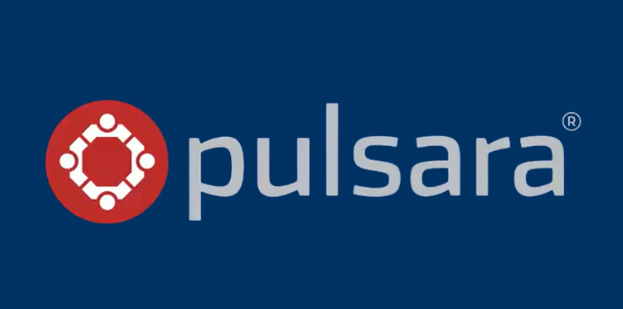
FOR QUESTIONS OR ADDITIONAL INFORMATION:
EHS2@ncttrac.org
Warehouse: 817.607.7002
Direct: 817.608.0390

Introduction
NCTTRAC is providing Texas EMS Wristbands and EMS Triage Wristbands to EMS, FRO, and Hospital organizations within Trauma Service Area – E to address two long-standing state-wide challenges:
- To link pre-hospital and hospital records across disparate electronic medical record systems and throughout the continuum of care
- To track patients during mass casualty incidents (MCI), evacuations, and disasters
Texas EMS Wristbands and EMS Triage Wristbands are FREE on a FIRST COME, FIRST SERVED BASIS while supplies and funds remain available. Wristbands will be appropriately distributed to DSHS-licensed EMS agencies, First Responder Organizations and hospitals to facilitate EMS transports, inter-facility transfers, and/or other NCTTRAC approved situations or events in which wristbands may be needed or required.
Both wristbands are available through NCTTRAC. While either wristband may be used interchangeably, each wristband was designed for specific use based on cost-effectiveness and functionality. Please review the specific structure and appointed organization type below:

Texas EMS Wristband: For everyday use by EMS & Hospitals only.
———————————————————————————————————————————————————————————————–

EMS Triage Wristband: For use by EMS & FRO’s only during mass casualty incidents (MCI).
EMS Program Overview
NCTTRAC recommends and encourages ALL organizations follow the program expectations and responsibilities outlined herein:
EMS Qualifications
- May request the Texas EMS Wristbands and the EMS Triage Wristbands.
- Be a DSHS Licensed Organization within Trauma Service Area-E
- Must have an active Pulsara User Account(s) for the agency
- Must have at least one (1) of the following three (3) memberships:
- NCTTRAC Membership
- EMTF MOA
- HPP LOA
- Attest to viewing the Texas EMS Wristband Project: Leadership Training Video
- Willing to sign or have on file a NCTTRAC Asset Transfer Agreement
Distribution is not available to those without an EMTF MOA, HPP LOA, or NCTTRAC Membership. Please contact NCTTRAC for any questions at NCTTRAC_EHS@ncttrac.org.
Program Performance Expectations

Texas EMS Wristbands – For Daily Use
- Place a Texas EMS Wristband on EVERY patient, EVERY day, by air or ground, transport or transfer to a destination facility. Preferentially place the wristband on the patient’s left wrist to minimize facility procedure interference.
- Upload the wristband’s unique identifier via the Pulsara platform and send communications to the destination facility, preferably prior to arrival.
- Enter the wristband’s unique identifier into a pre-identified, query-able National EMS Information System (NEMSIS) compliant field within the EMS agency’s electronic patient care report (ePCR).

EMS Triage Wristbands – For MCI events only
- Use the EMS Triage Wristband for MCIs only, if not available, use a Texas EMS Wristband. Regardless, the patient should receive only one wristband.
- Upload the wristband’s unique identifier via the Pulsara platform and send communications to the destination facility, preferably prior to arrival.
- Enter the wristband’s unique identifier into a pre-identified, query-able National EMS Information System (NEMSIS) compliant field within the EMS agency’s electronic patient care report (ePCR).
Pulsara Requirement
At the minimum, EMS, FROs, and Hospitals MUST be enrolled in Pulsara, have active Pulsara user accounts, and be willing to utilize Pulsara in MCI events in order to receive Texas EMS Wristbands and/or EMS Triage Wristbands through NCTTRAC. Please note, Distribution is not available to those without active Pulsara accounts. For information or help with enrolling in Pulsara; utilize the buttons on the right-hand side of the webpage for each organization type.
FRO Program Overview
NCTTRAC recommends and encourages ALL organizations to follow the program expectations and responsibilities outlined herein:
FRO Qualifications
- May only request the EMS Triage Wristband
- Be a DSHS Licensed Organization within Trauma Service Area-E
- Must have an active Pulsara User Account(s) for the agency
- Must have at least one (1) of the following three (3) memberships:
- NCTTRAC Membership
- EMTF MOA
- HPP LOA
- Attest to viewing the Texas EMS Wristband Project: Leadership Training Video
- Willing to sign or have on file a NCTTRAC Asset Transfer Agreement
Distribution is not available to those without an EMTF MOA, HPP LOA, or NCTTRAC Membership. Please contact NCTTRAC for any questions at NCTTRAC_EHS@ncttrac.org.
Program Performance Expectations

EMS Triage Wristbands – For MCI Events Only
- FROs will only be receiving the EMS Triage Wristband for MCI use only. As a reminder, patients should only receive ONE wristband.
- Upload the wristband’s unique identifier via the Pulsara platform and send communications to the destination facility, preferably prior to arrival.
Pulsara Requirement
At the minimum, EMS, FROs, and Hospitals MUST be enrolled in Pulsara, have active Pulsara user accounts, and be willing to utilize Pulsara in MCI events in order to receive Texas EMS Wristbands and/or EMS Triage Wristbands through NCTTRAC. Please note, Distribution is not available to those without active Pulsara accounts. For information or help with enrolling in Pulsara; utilize the buttons on the right-hand side of the webpage for each organization type.
Hospital Program Overview
NCTTRAC recommends and encourages ALL organizations to follow the program expectations and responsibilities outlined herein:
Hospital Qualifications
- May only request the Texas EMS Wristband
- Be a DSHS Licensed Organization within Trauma Service Area-E
- Must have an active Pulsara User Account(s) for the agency
- Must have at least one (1) of the following three (3) memberships:
- NCTTRAC Membership
- EMTF MOA
- HPP LOA
- Attest to viewing the Texas EMS Wristband Project: Leadership Training Video
- Willing to sign or have on file a NCTTRAC Asset Transfer Agreement
Distribution is not available to those without an EMTF MOA, HPP LOA, or NCTTRAC Membership. Please contact NCTTRAC for any questions at NCTTRAC_EHS@ncttrac.org.
Program Performance Expectations

Texas EMS Wristband – For Daily Use
Incoming EMS Patients
When receiving patients enter the facility with either a Texas EMS Wristband or an EMS Triage Wristband:
-
- Acknowledge receipt of EMS communications via the Pulsara platform, preferably prior to EMS arrival.
- Leave the wristband in place and do not remove.
- Enter the wristband’s unique identifier into a pre-identified query-able field within the facility’s electronic health record (EHR).
- If a wristband is accidentally removed – place a new wristband on the patient, cover or cross out the new barcode and unique identifier, and write the previous wristband’s unique identifier on the new wristband using a permanent marker
Outgoing Patient Transfers
When sending patients out of the facility:
-
- Place a Texas EMS Wristband on the patient (if one is not already in place)
- Enter the wristband’s unique identifier into a pre-identified query-able field within the facility’s ER prior to patient transfer.
- If a wristband is accidentally removed – place a new wristband on the patient, cover or cross out the new barcode and unique identifier, and write the previous wristband’s unique identifier on the new wristband using a permanent marker.
Pulsara Requirement
At the minimum, EMS, FROs, and Hospitals MUST be enrolled in Pulsara, have active Pulsara user accounts, and be willing to utilize Pulsara in MCI events in order to receive Texas EMS Wristbands and/or EMS Triage Wristbands through NCTTRAC. Please note, Distribution is not available to those without active Pulsara accounts. For information or help with enrolling in Pulsara; utilize the buttons on the right-hand side of the webpage for each organization type.
DSHS Rules Requirement

There is expectation that both the Texas EMS & EMS Triage Wristbands will be referenced within the Texas Department of State Health Services (DSHS) Rules, primarily within the revised Trauma Rules, as shown below:
Revised Trauma Rule §157.125: Requirements for Trauma Facility Designation
- Section 19, subsection (A); integration of the EMS patient care records, to include the EMS wristband tracking number.
- Section 27, subsection (E); The EMS wristband tracking number must be included in the registry abstraction and submission to the State Registry.
Emergency Medical Services (EMS) Rule §157.11: Requirements for an EMS Provider
- Subsection (k); Paragraph (7): EMS vehicles must also have: each vehicle will carry 25 triage tags in coordination with the Regional Advisory Council (RAC).
For further questions regarding the upcoming DSHS Rule Revisions, please contact the Emergency Healthcare Systems (EHS) Department at EHS2@NCTTRAC.org.
Allocation
For Texas EMS Wristbands (EMS & Hospitals Only)

-
- Agencies may receive an amount equal to their total number of recorded transports reported to DSHS in the previous year.
- Facilities may receive an amount equal to their total number of interfacility transfers for the previous year.
For EMS Triage Wristbands (EMS & FRO Only)

-
- To be placement on all EMS/FRO/Fire response units (e.g., engines, ambulances, EMS Supervisors vehicles, etc.) for use specifically during an MCIs.
- Each apparatus receives a bundle of 25 EMS Triage Wristbands to be utilized for MCIs. One-Time Bundle Provided Only.
For Additional Wristband Purchases:
For organizations who wish to purchase wristbands over the designated allocation amount, please contact the vendor information for each wristband type.
Texas EMS Wristbands EMS Triage Wristbands
Eric Grob Ryan Night | Senior Account Manager
Field Sales Manager- Healthcare State and Local Government
Mobile: 817.983.5725 ZEBRA TECHNOLOGIES CORPORATION
eric_grob@bradycorp.com Email: Ryan.Night@Zebra.com
Cell: 512-903-0156
Click the Image to view the Training Video series.

FOR QUESTIONS OR ADDITIONAL INFORMATION:
